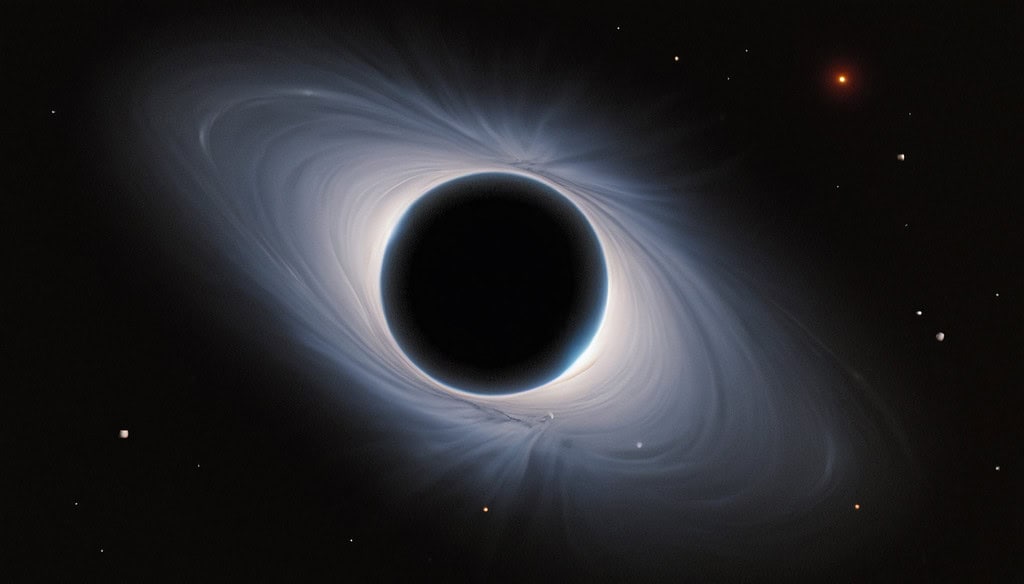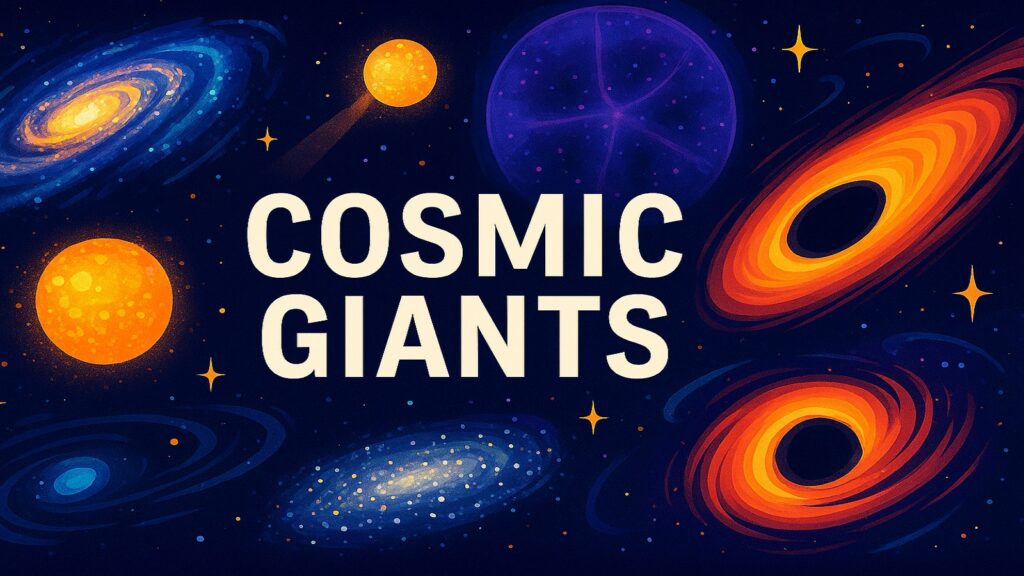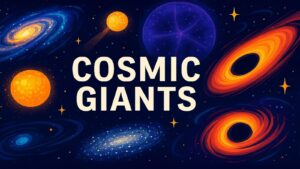Table of Contents
Introduction: Cosmic Giants – The Titans Sculpting the Vast Universe

The Universe stretches beyond imagination, filled with structures so massive and influential they dictate the flow of space and time itself. These are the Cosmic Giants—entities ranging from collapsed stellar cores to dark matter scaffolds extending across hundreds of millions of light-years. They are not simply large objects drifting through space. They are the architects of cosmic reality, shaping galaxies, driving evolution, and determining the ultimate fate of everything we observe.
Understanding Cosmic Giants means grasping how the Universe organizes itself at every scale. From black holes that warp spacetime into inescapable wells to superclusters that mark the largest known structures, these titans operate according to fundamental laws. In a companion article exploring the eight Cosmic Forces, we examined the rules governing the Universe—gravity, electromagnetism, nuclear forces, and others. Those forces set the stage. The Cosmic Giants are the actors, the players occupying and transforming that stage across billions of years.
What follows is an exploration of eight Cosmic Giants that define our cosmos. Each section reveals how these entities influence structure, evolution, and destiny on scales both intimate and incomprehensible. Together, they form a portrait of the Universe as a dynamic, interconnected system where the smallest remnants and the largest networks work in concert.
Cosmic Giants: Overview of the Eight Universal Titans
| Cosmic Giant | Primary Influence on the Universe |
|---|---|
| Black Holes | Gravitational dominance shaping galaxy cores and emitting powerful jets |
| Dark Matter | Invisible framework enabling galaxy formation and cluster assembly |
| Dark Energy | Accelerating cosmic expansion and determining ultimate fate |
| Stars & Supernovae | Element creation through fusion and explosive redistribution |
| Neutron Stars, Pulsars & Magnetars | Extreme density and magnetic fields pushing physics to limits |
| Galaxies | Star cities hosting billions of suns and complex ecosystems |
| Cosmic Web | Large-scale filamentary structure organizing matter distribution |
| Galaxy Clusters & Superclusters | Largest gravitationally bound systems anchoring cosmic geography |
1. Cosmic Giants: Black Holes – The Universe’s Deepest Wells of Gravity

Black holes represent gravity’s ultimate victory. When massive stars collapse or when matter accumulates at galactic centers over eons, spacetime curves so severely that nothing—not even light—can escape. These Cosmic Giants come in three main varieties. Stellar-mass black holes form from dying stars between roughly three and dozens of solar masses. Intermediate-mass black holes occupy a mysterious middle ground. Supermassive black holes, millions to billions of times heavier than our Sun, lurk at the hearts of most large galaxies.
Their influence extends far beyond their event horizons. Supermassive black holes regulate galaxy formation through feedback mechanisms. As matter spirals inward through accretion disks, friction heats material to millions of degrees, producing intense radiation and powerful jets that can extend thousands of light-years. These jets inject energy into surrounding gas, sometimes triggering star formation, sometimes suppressing it entirely. The gravitational pull of these monsters holds entire galactic cores in orbital dance.
Black holes serve as laboratories for extreme physics. Near their boundaries, time slows relative to distant observers. Space stretches and compresses in ways described by general relativity. When two black holes merge, they produce gravitational waves—ripples in spacetime itself—that we now detect from Earth. These Cosmic Giants are not merely passive endpoints of stellar evolution. They actively shape galactic structure, influence star formation rates, and provide windows into the fundamental nature of gravity and spacetime.
Cosmic Giants: Black Hole Properties and Influences
| Properties of Black Holes | Description |
|---|---|
| Formation Mass Range | Stellar (3-100 solar masses), Intermediate (100-100,000), Supermassive (millions to billions) |
| Event Horizon | Boundary beyond which escape becomes impossible |
| Accretion Disk Temperature | Can reach millions of degrees Celsius |
| Jet Extent | Extends up to thousands of light-years from source |
| Gravitational Wave Production | Mergers create detectable spacetime ripples |
| Galaxy Formation Role | Feedback regulates star formation and gas dynamics |
| Observational Evidence | X-ray emissions, stellar orbits, gravitational lensing |
| Time Dilation Effect | Time slows near event horizon relative to distant observers |
2. Cosmic Giants: Dark Matter – The Invisible Skeleton of Structure

Dark matter remains one of the most profound mysteries in physics, yet its presence pervades the cosmos. This Cosmic Giant composes roughly 85 percent of all matter, yet it neither emits nor absorbs light. We know it exists through gravitational effects that cannot be explained by visible matter alone. Galaxy rotation curves provided early evidence—outer regions of spiral galaxies rotate far faster than visible matter alone would allow, suggesting massive invisible halos.
Gravitational lensing offers another window. When light from distant galaxies passes through massive foreground clusters, it bends and distorts in ways that reveal far more mass than we see. The Bullet Cluster collision provided especially compelling proof. Two galaxy clusters passed through each other, separating ordinary matter (which interacted and slowed) from dark matter (which passed through largely unaffected). The gravitational lensing mapped dark matter’s location, confirming its separate existence.
Dark matter’s true power lies in structure formation. In the early Universe, slight density variations in dark matter began collapsing under gravity first, since dark matter does not interact electromagnetically and cannot be pushed back by radiation pressure. Ordinary matter fell into these dark matter wells, forming the first stars and galaxies. Every galaxy sits within a dark matter halo, sometimes extending ten times beyond the visible edge. Without this invisible scaffolding, galaxies as we know them could not exist. This Cosmic Giant built the framework upon which all visible structure assembled.
Cosmic Giants: Dark Matter Evidence and Characteristics
| Evidence / Property | Details |
|---|---|
| Composition of Universe | Approximately 27% of total energy density |
| Interaction Type | Responds to gravity but not electromagnetic forces |
| Galaxy Rotation Curves | Outer regions rotate faster than visible matter predicts |
| Gravitational Lensing | Bends light from background sources revealing hidden mass |
| Bullet Cluster | Separated ordinary and dark matter during collision |
| Halo Extent | Extends up to 10 times beyond visible galaxy boundaries |
| Structure Formation Role | Provided gravitational wells for first galaxies |
| Detection Methods | Gravitational effects, cosmic microwave background patterns |
3. Cosmic Giants: Dark Energy – The Force Driving the Universe Apart

If dark matter builds structure, dark energy tears it apart—or at least prevents further assembly at the largest scales. This Cosmic Giant accounts for roughly 68 percent of the Universe’s total energy density. Its nature remains enigmatic, but its effects are unmistakable. Dark energy generates a repulsive pressure that accelerates cosmic expansion, counteracting gravity’s attractive pull across vast distances.
The discovery came from observations of Type Ia supernovae in distant galaxies. These exploding white dwarf stars serve as standard candles because they reach predictable peak brightness. By comparing apparent brightness with known luminosity, astronomers measure distance. In the late 1990s, two independent teams found that distant supernovae appeared dimmer than expected. The Universe was not just expanding—it was accelerating. This revelation earned the 2011 Nobel Prize in Physics.
The cosmic microwave background provides additional evidence. Precise measurements of temperature fluctuations reveal the Universe’s geometry and composition. The data indicates a flat Universe dominated by dark energy, consistent with supernova observations. Dark energy’s consequences extend into deep time. If it remains constant, galaxies beyond our Local Group will eventually recede beyond visibility as space expands faster than light can cross it. This Cosmic Giant shapes not just the present structure but the ultimate destiny of the cosmos—a cold, diffuse, increasingly isolated future where even galaxy clusters drift apart into darkness.
Cosmic Giants: Dark Energy Properties and Cosmic Impact
| Property or Effect | Description |
|---|---|
| Universal Composition | Approximately 68% of total energy density |
| Primary Effect | Accelerates expansion of space itself |
| Discovery Method | Type Ia supernova distance measurements (1990s) |
| Equation of State | Appears consistent with cosmological constant |
| CMB Evidence | Temperature fluctuations indicate flat geometry with dark energy |
| Gravitational Behavior | Creates repulsive pressure at cosmic scales |
| Future Fate Influence | May lead to accelerating expansion indefinitely |
| Observable Consequences | Distant galaxies receding at increasing rates |
4. Cosmic Giants: Stars & Supernovae – The Engines of Element Creation

Stars illuminate the cosmos, but their true significance lies deeper than visible light. These Cosmic Giants are fusion reactors, converting hydrogen into helium and, in massive stars, forging elements all the way to iron through successive burning stages. Every atom of carbon in our bodies, every oxygen molecule we breathe, every iron atom in our blood—all were synthesized inside stars over billions of years.
Main-sequence stars like our Sun fuse hydrogen for billions of years, generating energy that counteracts gravitational collapse. More massive stars burn hotter and faster, progressing through helium, carbon, neon, oxygen, and silicon burning in their cores. Yet fusion becomes energetically unfavorable beyond iron. Massive stars accumulate iron cores that cannot generate energy, leading to catastrophic collapse and supernova explosions.
Supernovae represent stellar death transformed into cosmic rebirth. The explosion releases more energy in seconds than the star produced during its entire lifetime. Shock waves slam into surrounding gas, triggering new star formation. More importantly, supernovae create elements heavier than iron through rapid neutron capture, dispersing gold, uranium, platinum, and hundreds of other heavy elements into interstellar space. Without supernovae, the Universe would contain only hydrogen, helium, and trace lithium left over from the Big Bang. These explosive Cosmic Giants enriched the cosmos with the chemical complexity necessary for planets, oceans, and life itself.
Stellar Processes and Elemental Contributions
| Process or Property | Details |
|---|---|
| Hydrogen Fusion | Primary energy source converting hydrogen to helium |
| Advanced Burning Stages | Massive stars fuse helium, carbon, oxygen, silicon |
| Fusion Endpoint | Iron core formation halts energy generation |
| Supernova Energy Release | Can outshine entire galaxies briefly |
| Heavy Element Creation | Rapid neutron capture produces elements beyond iron |
| Chemical Enrichment | Disperses created elements into interstellar medium |
| Star Formation Trigger | Shock waves compress gas clouds initiating collapse |
| Biological Necessity | Provides carbon, oxygen, nitrogen, phosphorus for life |
5. Cosmic Giants: Neutron Stars, Pulsars & Magnetars – The Universe’s Extreme Remnants

When stars between roughly 8 and 20 solar masses explode as supernovae, their cores collapse into neutron stars—objects so dense that a sugar-cube-sized chunk would weigh as much as Mount Everest. These Cosmic Giants pack more than the Sun’s mass into a sphere only 20 kilometers across. Gravity compresses protons and electrons into neutrons, creating matter at nuclear densities found nowhere else in the Universe.
Neutron stars spin rapidly, sometimes hundreds of times per second, conserving angular momentum from their progenitor stars. When magnetic fields align with rotation axes, they become pulsars—cosmic lighthouses sweeping beams of radiation across space with clockwork precision. Astronomers discovered the first pulsar in 1967, initially mistaking its regular radio pulses for possible alien signals. Pulsars serve as natural laboratories for studying matter under extreme conditions and as precise cosmic clocks.
Magnetars represent the most extreme subset. Their magnetic fields reach intensities quadrillion times stronger than Earth’s, powerful enough to distort atomic electron clouds from light-years away. During outbursts, magnetars release enormous bursts of X-rays and gamma rays, sometimes visible across the galaxy. These fields decay over thousands of years, but while active, magnetars rank among the most magnetically powerful objects known. Neutron stars may be small by cosmic standards, but their influence as Cosmic Giants derives from pushing physical properties—density, magnetism, rotation—to extremes found nowhere else.
Neutron Star Properties and Variations
| Property or Type | Description |
|---|---|
| Formation Mass Range | Progenitor stars between 8-20 solar masses |
| Final Mass | Typically 1.4 to 2 solar masses compressed |
| Diameter | Approximately 20 kilometers across |
| Density | Nuclear density, about 400 trillion times water |
| Rotation Rate | Can spin up to 700 times per second |
| Pulsar Mechanism | Magnetic field beams sweep across space |
| Magnetar Field Strength | Up to quadrillion times Earth’s magnetic field |
| Discovery Date | First pulsar detected in 1967 by Jocelyn Bell Burnell |
6. Cosmic Giants: Galaxies – The Star Cities of the Universe

Galaxies are the fundamental building blocks of cosmic structure, vast islands of stars, gas, dust, dark matter, and supermassive black holes bound together by gravity. These Cosmic Giants range from dwarf galaxies containing millions of stars to massive ellipticals hosting trillions. Our own Milky Way is a barred spiral galaxy with roughly 200 to 400 billion stars, stretching about 100,000 light-years across.
Galaxy morphology reveals evolutionary history. Spiral galaxies like the Milky Way and Andromeda feature rotating disks with sweeping arms where active star formation continues. Elliptical galaxies appear smoother and redder, their star formation largely exhausted, often resulting from galaxy mergers. Irregular galaxies lack organized structure, sometimes disturbed by gravitational interactions or ongoing collisions. Each type represents different stages and pathways in galactic evolution.
Galaxies are ecosystems, not just stellar collections. Star formation occurs in dense molecular clouds within spiral arms. Supernovae enrich gas with heavy elements, which become incorporated into new stellar generations. Supermassive black holes at galactic centers regulate gas flow and star formation through energetic feedback. Dark matter halos provide gravitational scaffolding, extending far beyond visible boundaries. Galaxies interact through their history, merging and exchanging material over billions of years. As Cosmic Giants, galaxies represent the primary venues where cosmic evolution occurs—where stars are born, elements are forged, and complex structures emerge from primordial simplicity.
Galaxy Types and Characteristics
| Property or Type | Description |
|---|---|
| Spiral Galaxies | Rotating disks with arms showing active star formation |
| Elliptical Galaxies | Smooth, older stellar populations with minimal gas |
| Irregular Galaxies | Lack organized structure, often gravitationally disturbed |
| Milky Way Type | Barred spiral containing 200-400 billion stars |
| Typical Size Range | Dwarfs with millions to giants with trillions of stars |
| Dark Matter Component | Halos extend 10 times beyond visible matter |
| Central Engine | Supermassive black holes regulate galactic evolution |
| Evolutionary Process | Mergers and interactions reshape structure over time |
7. Cosmic Giants: The Cosmic Web – The Universe’s Grand-Scale Architecture

Zoom out far enough and galaxies themselves become mere points in a vaster tapestry. The Cosmic Web represents the Universe’s large-scale structure—a vast network of filaments, walls, nodes, and voids shaped by gravity, dark matter, and cosmic expansion. This Cosmic Giant emerged from tiny density fluctuations in the early Universe, amplified over billions of years into the grandest pattern visible in nature.
Filaments are the web’s defining feature. These tendrils of galaxies and dark matter stretch across hundreds of millions of light-years, connecting clusters at nodes where multiple filaments intersect. Between the filaments lie voids—vast, relatively empty regions spanning similar distances where few galaxies exist. The Sloan Digital Sky Survey mapped this structure in unprecedented detail, revealing patterns resembling neural networks or biological tissues at unimaginable scales.
Dark matter drives web formation. In the early Universe, dark matter clumped first, creating gravitational potential wells. Ordinary matter flowed along dark matter filaments like water following riverbeds downhill. Galaxies formed where filaments provided steady gas supplies. Over time, cosmic expansion stretched the web, while gravity continued pulling matter into filaments and clusters. The Cosmic Web represents the largest known structure in the Universe—not a single object but an interconnected network encompassing everything. Understanding this Cosmic Giant means grasping how the Universe organizes matter at scales where individual galaxies become insignificant specks in a pattern billions of light-years across.
Cosmic Web Structure and Formation
| Component or Property | Description |
|---|---|
| Filaments | Tendrils of galaxies stretching hundreds of millions of light-years |
| Nodes | Cluster intersections where filaments meet |
| Voids | Vast relatively empty regions between filaments |
| Scale | Structures extend across billions of light-years |
| Dark Matter Role | Provides gravitational framework for visible matter |
| Formation Driver | Gravity amplifying early density fluctuations |
| Observational Mapping | Sloan Digital Sky Survey revealed detailed structure |
| Appearance | Resembles foam or neural network at cosmic scales |
8. Cosmic Giants: Galaxy Clusters & Superclusters – The Universe’s Most Massive Structures

Galaxy clusters are the most extensive structures in the Universe that are held together by gravity. These Cosmic Giants contain hundreds to thousands of galaxies held together by immense dark matter halos, with hot gas filling the space between galaxies and glowing in X-rays. The Virgo Cluster, containing over 1,300 galaxies, lies about 54 million light-years away and dominates our local cosmic neighborhood. The Coma Cluster houses thousands of galaxies bound together over millions of years.
Superclusters extend beyond gravitational binding. These are loose associations of multiple galaxy clusters aligned along cosmic web filaments. Our Milky Way resides in the Laniakea Supercluster, a structure spanning 520 million light-years and containing roughly 100,000 galaxies. The supercluster’s mass creates a gravitational basin, with galaxies flowing toward a central concentration called the Great Attractor. The Hercules-Corona Borealis Great Wall stretches approximately 10 billion light-years across, ranking among the largest known structures.
These Cosmic Giants anchor cosmic geography. Clusters serve as signposts marking web nodes. Their X-ray emissions allow study of hot intergalactic gas accounting for more mass than galaxies themselves. Gravitational lensing from clusters bends light from background galaxies, revealing dark matter distribution. Clusters preserve records of cosmic evolution, showing how structures assembled over billions of years. While dark energy now accelerates expansion at the largest scales, clusters and their immediate surroundings remain gravitationally bound, creating islands of ongoing assembly in an increasingly dispersed Universe. As the ultimate Cosmic Giants, they define the upper limits of cosmic structure.
Cluster and Supercluster Properties
| Structure or Property | Description |
|---|---|
| Galaxy Cluster Size | Contains hundreds to thousands of galaxies |
| Virgo Cluster | Over 1,300 galaxies approximately 54 million light-years away |
| Hot Gas Component | X-ray emitting plasma between cluster galaxies |
| Dark Matter Dominance | Makes up majority of cluster mass |
| Laniakea Supercluster | Our supercluster spanning 520 million light-years |
| Hercules-Corona Borealis Great Wall | Structure extending roughly 10 billion light-years |
| Gravitational Lensing | Clusters bend background light revealing mass distribution |
| Cosmic Geography Role | Mark nodes in cosmic web defining large-scale structure |
Conclusion: Cosmic Giants – The Titans That Continue to Shape the Universe

The Universe reveals itself through hierarchy and connection. Black holes sculpt galactic cores, focusing matter and energy with gravitational intensity found nowhere else. Dark matter provides the invisible framework, building scaffolds upon which visible structure assembles. Dark energy pushes against this assembly, accelerating expansion and determining ultimate fate. Stars forge elements through fusion and distribute them through supernova explosions, enriching the cosmos with chemical complexity. Neutron stars and magnetars push physical properties to extremes, serving as laboratories where matter behaves in ways impossible elsewhere.
Galaxies host this evolution, providing venues where stars form, black holes grow, and cosmic cycles repeat across billions of years. The Cosmic Web organizes everything into the grandest pattern, connecting structures across unfathomable distances. Galaxy clusters and superclusters mark the upper limits, massive enough to resist even dark energy’s expansion in their immediate vicinities. Each Cosmic Giant plays a role. Remove any and the Universe transforms into something unrecognizable.
Together with the Cosmic Forces explored in the companion article, these Giants complete the picture. Forces provide rules—how gravity attracts, how matter interacts, how energy flows. Giants provide structure—the players occupying the stage those rules create. Neither exists without the other. The interplay between fundamental laws and massive structures shapes cosmic destiny from the smallest scales to the edge of observable space. Understanding Cosmic Giants means understanding not just what exists, but how and why the Universe organizes itself into patterns that persist across time and distance beyond human comprehension.
Key Observational Milestones in Understanding Universal Structure
| Discovery or Observation | Scientific Significance |
|---|---|
| First Pulsar Detection (1967) | Revealed existence of neutron stars and extreme physics |
| Galaxy Rotation Curves (1970s) | Provided early evidence for dark matter halos |
| Type Ia Supernova Studies (1998) | Discovered accelerating expansion from dark energy |
| Gravitational Wave Detection (2015) | Confirmed black hole mergers and spacetime ripples |
| Bullet Cluster Observation (2006) | Separated dark matter from ordinary matter visually |
| Sloan Digital Sky Survey Mapping | Revealed cosmic web filamentary structure in detail |
| Event Horizon Telescope Image (2019) | First direct image of supermassive black hole shadow |
| Cosmic Microwave Background Precision | Determined universe composition and geometry accurately |




